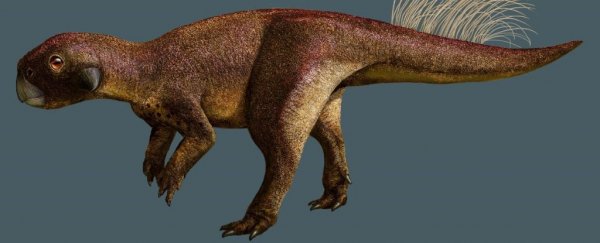The oldest 'belly button' known to science has been found on an exquisitely preserved horned dinosaur fossil from China.
The slit-like scar comes not from an umbilical cord, as it does in mammals, but from the yolk sac of the egg-laying creature that lived about 130 million years ago.
Today, many living snakes and birds lose their so-called umbilical scar within days or weeks of an egg hatching. Others, like adult alligators, keep them for life.
This is a picture of an American alligator belly button (umbilical scar.) You're welcome #BellyButtonScience #alligator #gator #bellybutton pic.twitter.com/GZt2EhA0oD
— Dr. Anne A Madden (@AnneAMadden) February 1, 2017
The umbilical scar found on the Psittacosaurus dinosaur is more similar to alligators, lasting until at least sexual maturity and possibly long after that.
It's the first example of a belly button in a non-avian dinosaur, predating the arrival of 'recent life' in the Cenozoic, about 66 million years ago.
The discovery doesn't mean that all land dinosaurs sported the same persistent umbilical scar, but it leaves open the possibility.
"This Psittacosaurus specimen is probably the most important fossil we have for studying dinosaur skin," says vertebrate paleontologist Phil Bell from the University of New England in Australia.
"But it continues to yield surprises that we can bring to life with new technology like laser imaging."
The dinosaur fossil of the Psittacosaurus genus, known as SMF R 4970, was found in China in 2002. It is exquisitely preserved, showing individual scales, long plumes of tail bristles, and the first cloaca ever seen in a non-avian dinosaur.
Lying on its back, the individual is practically presenting all its details to scientists.
 3D reconstruction of a reclining Psittacosaurus showing the long umbilical scar. (Jagged Fang Designs)
3D reconstruction of a reclining Psittacosaurus showing the long umbilical scar. (Jagged Fang Designs)
Using detailed laser imaging, researchers have now been able to identify a change in the pattern of skin and scales right where the dinosaur's belly button would be, representing where the yolk sac was reabsorbed by a young dinosaur.
Similar to the umbilical cord, the yolk sac is what feeds the growing embryo inside the egg with oxygen and nutrients; there's another connected clear sack, the allantois, which collects the waste inside an egg. Before an animal hatches, these connections seal up, leaving a long scar.
Researchers have long hypothesized that egg-laying dinosaurs would possess such a scar, but this is the first evidence to back up that idea.
Fossils of soft tissue are rarely preserved among dinosaurs, but SMF R 4970 gives us an unprecedented glimpse at a thin column of paired scales on an ancient abdomen.
The regular size of the scales and their smooth margins suggests the scar was not brought about by physical trauma or disease.
Instead, its similarity to alligators strongly suggests we are looking at a belly button.
 Laser image of the Psittacosaurus umbilical scar, with close-ups of its scales. (Bell et al., BMC Biology, 2022)
Laser image of the Psittacosaurus umbilical scar, with close-ups of its scales. (Bell et al., BMC Biology, 2022)
"Using LSF imaging, we identified distinctive scales that surrounded a long umbilical scar in the Psittacosaurus specimen, similar to certain living lizards and crocodiles," says paleontologist Michael Pittman from the Chinese University of Hong Kong.
"We call this kind of scar a belly button, and it is smaller in humans. This specimen is the first dinosaur fossil to preserve a belly button, which is due to its exceptional state of preservation."
From a fully-fledged butthole to a clear belly button, the SMF R 4970 fossil has really put its most private parts on display.
The study was published in BMC Biology.
